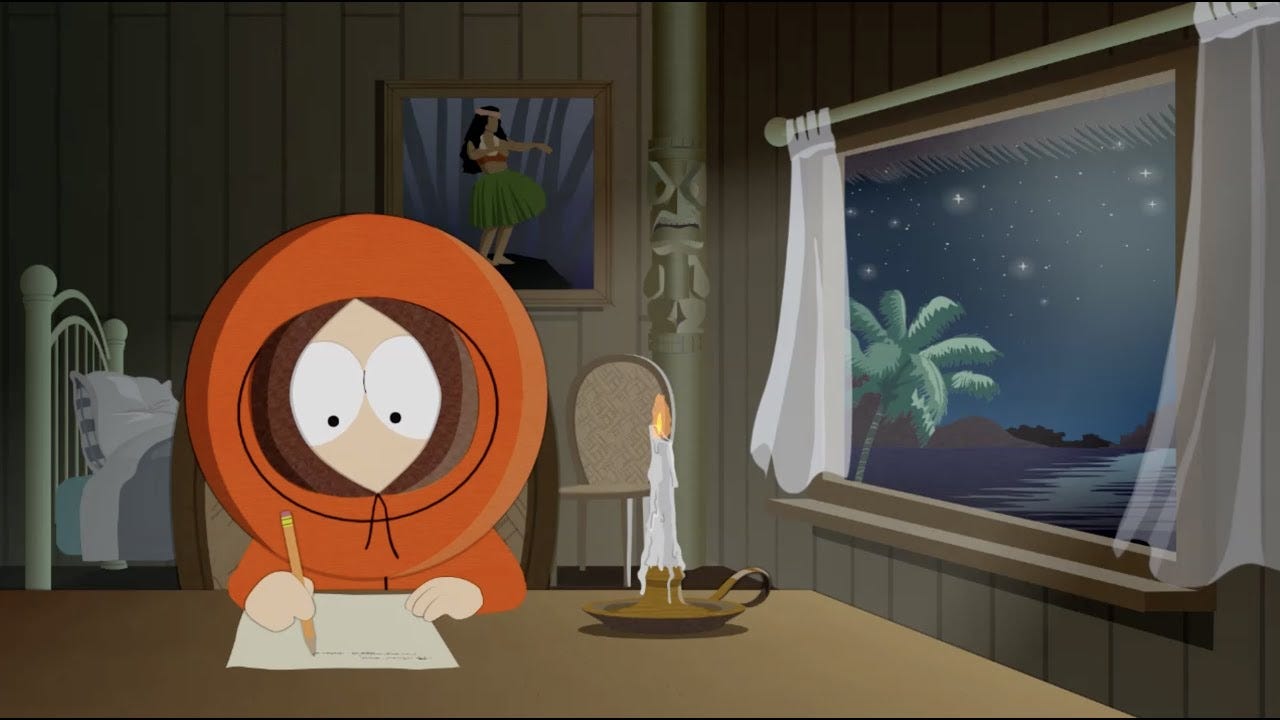How To Write A Razor-Sharp Category POV
Can you believe the formula comes from these guys?
They've ruthlessly mocked every religion, identity, political party, and just about any controversial topic you can imagine.
So how can it be possible they hold the key to the perfect communication of your enterprise SaaS product? Or Feminine care product? Or any other product you happen to be working on?
It’s because, with over 320 episodes released and 27 years on air, Trey Parker and Matt Stone, the creators of South Park, have unlocked a storytelling trick that keeps their stories razor sharp.
You might have heard it before, but what does it have to do with Category Design POV statements?
Well, as I promised in my last post, your unique Point-Of-View (POV) can slice through a market and reshape it in your image. It is the key to unlocking a great category name, and even write your category name for you.
But only if you make it razor sharp.
This article is about how to do that.
Tell me what you do in less than 30 seconds minutes
I’ve worked in marketing for more than 2 decades. But with the exception of one project I did for Pringles back in 2007, my job has never been about magicking up something new to say about an uninteresting product.
Instead, I’ve always marketed innovations that are so interesting, they have too much to say. You know that feeling when you can’t explain what you or your product does in less than 30 minutes? I mostly work on challenges like that.
That’s what I found when I first met JT and Ely, Co-Founders at Bryte to interview for the role of CMO.
In a sleek room above the Steinway Piano showroom in downtown Los Altos, CA, they introduced their first generation Bryte Bed, and gave me a 45 minute tour through the many features of the bed, which included
The smart heating and cooling, which unlike other products, used air rather than water - for a very specific reason
The 100 AI-controlled smart cushions inside, which could autonomously adjust pressure by the inch at any point on the mattress
The internal engineering that powered them, including the world’s only totally silent valves
The relaxation feature that could lull you to sleep with an otherworldly physical sensation
And many more
Each of the aspects they presented were more than just a feature. They were manifestations of their unique POV’s on how a mattress should be. Each had a specific reason to exist, and was made in a very specific, opinionated way.
Bryte suffered no shortage of unique opinions about the product. If anything they had too many. But what did it all come down to? What was the one thing to stick in a customer’s mind that they could tell their friends why they should consider this bed?
We couldn’t say.
By which I mean: we literally couldn’t say. Not in less than 30 minutes anyway.
As I joined the company in January 2020 and took the CMO’s chair, I started trying to distill the various POVs using various formats like a manifesto, blog post or “anthem” video script. Each one I created was bloated with multiple competing POV narratives, none were getting closer to a singularity.
Without a reliable framework for writing a sharp POV, I couldn’t figure out how to isolate the one narrative that mattered most.
If I only knew then, what I’m about to share with you now.
Plotting A Valuable Category POV
In Lean Category Design, we believe the one most important thing to get across is how you see the problem differently to everyone else.
This is known as your contrarian POV.
As described in my last article - How Category Designers Unlock Killer Category Names - a good POV sets up the category bisection that slices the market in two and reshapes it in your image. By stating the need for a new category based on your POV, you create a dividing line based on whether or not products agree with you.
But like I said, only if it sharp. And it is only sharp if it clearly focuses one point, without any fluffy padding wrapped around it.
How To Remove Plot Distractions
The enemy of a sharp POV is including multiple POV’s in the form of everything you want to say about your solution and can’t bear to leave out.
The trouble is, editing is really, REALLY hard. Whoever said “Less is more” should actually have said “Less is more difficult.” Even the most accomplished writers and editors struggle to leave out superfluous content from their story, especially when they are proud of the effort they put into it.
That’s where this technique from South Park creators Matt Stone and Trey Parker comes in.
Have a quick watch - it’s just a few minutes.
In the clip, Matt and Trey don’t explicitly explain WHY this method works. But in my view, it is because the structure of But or Therefore eliminates anything that is not central to the narrative in a causal way.
“BUT” Creates Tension
When two scenes are linked by “but” there is an intrinsic tension between them.
This matters because creating tension is the very essence of storytelling. What keeps you hooked on reading or watching any story, is some tension that you become desperate to see resolved.
I was going to write more to explain this, BUT, by complete coincidence, storytelling expert
wrote about exactly this just a few days ago.Another way to identify tension is to look for the “but” statements that you could make when talking about the story. George needs to put the lasagna down but Gracie’s terrarium is half-built on the table. Jason and Macy are wild about each other but they both fear rejection so they haven’t acted on it yet. Gatsby wants Daisy back but she’s married to another man. And so on.
From Let’s Make Things Tense on
“But” doesn’t only create tension, it ensures necessity
In a story of (Scene A) BUT (Scene B), both A and B are essential, else there is no tension. Neither A nor B can be left out.
“Therefore” Creates Inevitability
When a story plays out as (Scene A) THEREFORE (Scene B) there is causal between the two.
Scene B is established as direct result of Scene A. This means Scene B MUST be included in the story, else the audience is left hanging, unresolved and unsatisfied by Scene A.
While having an unessential scene or two may sound harmless, in practice it can destroy your story.
These are the scenes that end up boring you as a viewer or even confusing you. You’ve know what I’m talking about. It’s those scenes that make you turn to your partner on the drive home from the movie theatre and say “WTF was that whole umbrella bit all about?”
Worse still, superfluous story beats can mislead an audience, taking them away from the intended narrative and down an unintended path. It consumes their cognitive CPU by giving them multiple narratives to follow and try to piece together what they are supposed be drawing from all this.
Is this about boy meets girl? Or boy defeats Death Star?
But never mind movies - ever felt this way after hearing the pitch of an entrepreneur who blurts out multiple features and benefits for minutes on end?
This Is The Unlock For Your Category POV
The many features and benefits of your product are akin to the many scenes of a writer’s plot.
All writers find it difficult to omit beloved scenes they have painstakingly written, just as all innovators feel pained by not mentioning every invention and achievement of their product.
So the rules are much the same.
Your Story Must Create Tension
In Category Design, you’re not just asking customers to choose your product vs that of a close competitor, you’re asking them to abandon their old ways and adopt new mindsets and behaviors.
That means you need to make damn clear why their default “old way” is no longer acceptable. You need to create a tension between the old and new by making the problem visible, and creating a tension that can only be resolved by new action, not by inaction in the form of the old way.
Seth Godin wrote about how “Marketers create tension” and described that tension as “the promise that we can get through that fear to the other side.”
That’s precisely what your category POV needs to do.
Solutions need to feel inevitable
You are introducing something very new, which makes it scary. Risky even.
You need to completely flip that on its head and make it sound like choosing your way the only logical decision. Everything else would be stupid.
Let’s look at how…
How to create a Lean Category POV
Many brand or category POV’s are first articulated in the form of an inspirational manifesto, executed as a blog post or as an “Anthem Video.”
These are fun to create and consume, but it is too easy to lose the plot within them. As you set out to write a POV, you likely have many POV’s swimming around and these long form formats allow them the space to coexist, which you absolutely do not want. When multiple POV’s compete with each other, neither you nor your audience has much chance of hearing the one narrative that matters.
It’s much better to start with the shortest possible form of a POV statement, so there is no possible space for multiple POVs. This is why, in my development of the Lean Category Design process over the last 8 years, I have sought ever shorter and more succinct frameworks for a POV.
Nowadays I start with this format inspired by Matt & Trey’s aforementioned technique, then expand it to a longer form artifact once I know it is singular, focussed, and sharp as hell.
The South Park Inspired “CBT” POV Statement
My interpretation of Matt & Trey’s method works like this:
A. Context
First you state of the problem in plain, obvious terms. This is the consensus part of the problem statement, meaning that it should be easy to agree with. This statement should something that instantly resonates with customers, but because it is the consensus view, might be something that your competitors agree with too.
Now. When you word it, weave in some sense of how and why the context around the problem has changed. Typically you’d explain why it is only getting worse. This gives urgency to the problem and creates that all important tension we mentioned earlier.
B. But
Having established the problem in a way that is easy for people to identify, you now introduce the plot twist, by telling them what you know - but nobody else knows - about the true nature of the problem
Here you are making a switch from the consensus (everyone easily agrees with) statement, to the contrarian (nobody else gets it) statement.
I’ll emphasize this point, because it’s important: This is your contrarian view on the problem, not on the solution.
By taking a beat to explain what’s wrong with everyone else’s understanding of the problem, you reveal a newly obvious reason why nobody else’s approach has ever solved the problem properly.
That increases the tension, but starts to get your audience excited, because they are already trying to guess the ending. By which I mean they are already guessing that you are about to reveal the first and only type of solution that does address this now obvious truth about the problem.
Which, of course, you do…
C. Therefore
Now that you have established a completely fresh insight on the problem, you have setup the need for an entirely new category of product that “thinks this way.”
All you now need to do, is introduce the need for an entirely new category of solution, that answers the freshly unearthed “But” statement about the problem. This is what
refers to as “writing the RFP for the category.” By which he means describing what a category of solutions must be in order to be considered valid.It is radically different because your insight on the problem was completely unique - meaning nobody else has seen it that way before - therefore the solution must be completely unique as well.
This ensures the singularity of your POV. By which I mean that all the other POVs you have about other aspects of your solution drop to secondary messaging, because this is the core narrative that reshapes the whole market around your framing.
It also makes your solution seem inevitable, because it is the only logical answer to the problem that you have just made visible.
Let’s look at some Examples
Dyson
Context: We all hate it when our vacuum cleaners lose suction and fail to pick up dirt (Consensus view on problem)
But: The problem is not the motor, it’s actually the bag. (Contrarian view)
Therefore: We need a very different type of vacuum that doesn’t have a bag, so never loses suction.
This is my paraphrasing of their early message. It lacks a view of how the context has shifted over time, but I love this because it is so clear that the bag - not the motor - is the real problem. It makes the notion of a bagless vacuum utterly inevitable.
Figma
Context: The pace and scope of modern interface design projects requires using specialist interface design tools
But: Successful interface design doesn’t come from individuals working in isolation, it takes a whole team
Therefore: You need an interface design tool that is purpose built for cross-functional collaboration
Also my paraphrasing, but I use this because it states as consensus the existing category that Sketch has already established (Interface Design rather than general design), but then depositions that whole category with the POV around collaboration, which Figma had more of a superpower for.
Bryte
Here’s how I eventually reconciled the POV for the smart mattress I mentioned in the beginning
Context: In the post-pandemic era, ever more of us realize the value of sleep as the foundation of health and wellness, driving the booming sleep tracking trend.
But: Real people don’t sleep just to score, they sleep to feel restored.
Therefore: We need sleep technology that’s purpose built to make you feel much more restored by your sleep
In this example, the “sleep to score” statement was a depositioning of both the sleep trackers that only track (score) sleep, but do nothing to improve it, as well as certain sleep tech competitors that over optimize for amount of deep sleep, which is not the only thing you need to feel restored.
This is how you find singularity in your POV and narrative.
Notice how all of these examples only carry one POV.
They are sharp because there is only one narrative thread to follow. There is no “and” in here, which prevents any secondary narrative POVs entering to confuse everything. It’s as tight and sharp as can be. They make only one point.
Now you have such a clear view of your singular POV, you can safely expand it back out to a manifesto post, vision video and more.
Now for the funnest part of all, which is when this sharp POV inevitably names your category for you.
How a CBT POV bisects markets and names categories
In my previous article I promised that a sharp POV can name your category for you, by bisecting a market around the agree / disagree sides of your statement.
To resolve the above examples, you can see how they easily write for you the category names of:
Bagless vacuum
Collaborative Design Software
Restorative Sleep Tech
See how these suddenly feel inevitable?
If you believe the bag is why vacuums lose suction, Then you need a bagless vacuum
If you believe interface design is a collaborative process, Then you want collaborative design software
If what you most want from your sleep is to feel restored Then you should choose restorative sleep technology
Does This Make sense?
If you need any more help forming your own POV with this method, book a free and non-salesy office hours chat with me and I’ll be happy to help.
If you enjoyed this article - or even better - found it valuable, please help me help others with it by pressing like, sharing/restacking it or sending it to a friend.
And of course, double check that you’re subscribed to receive future articles as soon as I publish them.
Thanks for reading!







Good read Chris. I really appreciated your note about de-positioning sleep trackers, because "de-positioning" is an underappreciated approach. But since buyers already have pre-conceived notions that might not line up with your POV, you have to be proactive about dealing with them.
Have you seen the documentary “6 Days to Air”? It really details their process from beginning to end in the episode creation.
There was also one they did in which they wrote and animated an entire story over Zoom. I haven’t seen that one yet but it’s said to be very good.